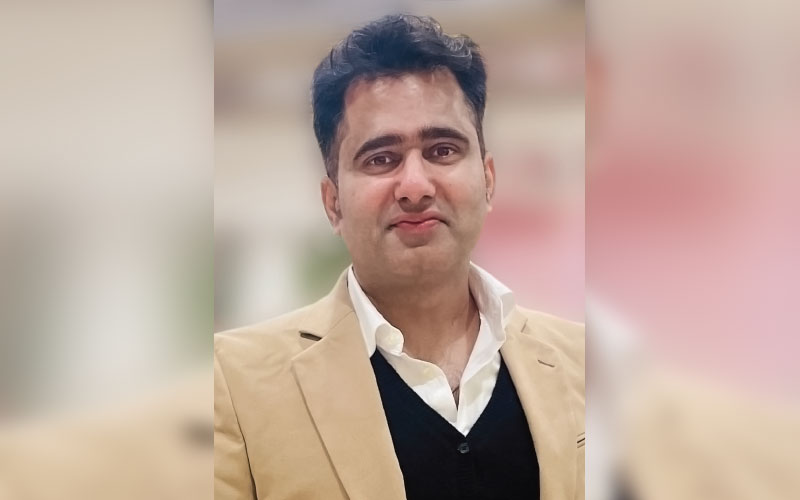Sidhu Engineering Works’ Robo Cleaner is helping the paper industry getting closer to achieve water circularity by saving 92% water consumption during the showering process without compromising on paper quality, and cleaning the paper mill’s fabric, felt and wire sections. It is also coming up with a new variant which has a dryer screen cleaning system. The innovative product will increase the paper machine’s runnability and reduce the steam consumption per ton of paper. It will also reduce paper breaks and improve the formation of the paper. This was revealed by Mr. Rahul Basra, Director of Sidhu Engineering Works, during an exclusive chat with Paper Mart.

Paper Mart: How has awareness towards water circularity evolved over time? How are you helping mills to achieve it?
Rahul Basra: Some 10-12 years ago, the industries used fresh water in all their processes and threw the waste water in drains. Since the industries were located near agricultural areas, the treated water would find its way to the fields through the drains, where it was used for agricultural purposes. The rest of the water would be either absorbed by the soil or reached the rivers, thus polluting the groundwater in 1-2 km area around these mills. Farmers used the polluted water for cultivating various crops, vegetables and fruits. This contaminated crop led to various diseases, such as cancer. When the Modi government came to power in 2014, it strictly implemented the environmental guidelines.
This was followed by the Central Pollution Control Board (CPCB) guidelines in 2019 regarding the use of water by the industries. The guidelines made it mandatory for all industries, including the pulp and paper industry, to reduce freshwater consumption in mills and maximise use of treated wastewater.
All paper mill owners started adopting ways and technologies to reduce the use of freshwater in their mills, thereby using backwater and recycled water in various processes. However, runnability is different in showering, and the mills could not use backwater in this particular process. This is where we came into the picture. We conducted audits and spread awareness on how to save water in paper mills, especially during the showering process.
PM: How widely are circular water systems (such as ZLD, membrane filtration, biological treatments, or AI-based monitoring) being adopted in paper mills? What adoption trends are you noticing?
RB: Right now, a lot of paper mills are using treated water in their low pressure (LP) showers, in vacuum ceiling water and in the pulp mill section. However, to maintain paper quality, mills must use freshwater. If they use treated water in showers, wire & press sections and vacuum ceiling, their paper quality may suffer.
Following the Waste Water Generation Standards issued by CPCB in 2019, we innovated a Robo Cleaner system to clean the paper mill’s fabric 24×7 with the help of 92 percent water saved through existing showers. Robo Cleaner can clean the felt and wire sections 100 percent and also save 92 percent water consumption in the mill.
Watch: In Pursuit of Lesser Water Footprint
PM: What are the key challenges your clients face in improving water management or achieving circularity?
RB: While aiming to achieve water circularity, clients face several challenges, such as loss of production, compromised paper quality, and smelling issues. They also have to use a lot of chemicals in ETP to reduce its COD and BOD.
PM: How do you co-create solutions with mills?
RB: Sidhu Engineering Works visits paper mills and conducts a water audit. We tell the customer how much water they are using, especially the quantity of water they are using to clean the paper machine fabric, and their water score. We then design the best solution for our clients, keeping in mind the paper machine’s speed, paper quality and raw material. We tell them about our technologically-advanced products, such as Robo Cleaner, which can save enormous amounts of water during the showering process without compromising on paper quality.
Robo Cleaner is a game changer, which can drastically reduce water consumption by 92 percent, enabling the mill to achieve zero liquid discharge (ZLD). Suppose a paper mill requires 300 m3 water to produce 300 tonnes paper per day. A pulp mill can use treated water in a variety of sections, including the mill, ETP, boiler, vacuum ceiling, LP shower and paper machine. However, it cannot use treated water in the HP shower segment.
Showering is the only system where we have to use only fresh water to maintain the machine’s runnability. So in order to produce 300 TPD paper, a mill will require 300 m3 freshwater in its HP shower. If 50 percent of water evaporates in the process, the paper mill is left with 150 m3 water in surplus. What should they do with this? The solution is to install Robo Cleaner in the wire and felt section. It will reduce water consumption by 92 percent, meaning your water consumption will come down to 24 m3. You will save 276 m3 water. You won’t need water from the ground. You won’t need to drain water outside. If you want to achieve ZLD, then you should reduce freshwater consumption in the showering system by installing an advanced technological product.
PM: Can you share examples of cost efficiency or gains achieved by mills using your systems for water recycling or ZLD? Are there examples of partnerships that led to better water management outcomes?
RB: About a year ago, we conducted a water audit of Shreyans Industries Limited, situated in Ahmedgarh, Punjab. After our installation and services, their water consumption reduced by 50 percent, from 1200 m3 per day to 600 m3 per day. Till date, they have not faced any quality issues or any kind of problem with the runnability of the machine.
Recently, we installed our Robo Cleaner no.8 at a kraft paper manufacturing machine in Vapi, which is one of the fastest paper machines in India right now. Water consumption was reduced by 90 percent without compromising on the machine’s runnability or paper quality. Even the life of the felt and wire sections increased.
We have also installed our Robo Cleaner at Shree Ajit Pulp and Paper Limited and at Akshat Papers Limited. We did a complete project for HRA Paper Mills Private Limited. One of our biggest clients is ITC Paperboards and Specialty Papers Division (ITC-PSPD). We installed a Robo Cleaner in the wire section of their Tribeni unit around six months back and achieved positive results. After that they placed several orders with us for their Kovai and Bhadrachalam units. So, we’re getting a good response. We recently installed a Robo Cleaner at JK Paper Limited, Songadh, Gujarat. Major big paper mills prefer using our products.
Also Read: Scan Engineering: Helping Mills Improve Water Management Through Turbo Clean Systems
PM: Are you doing some R&D or innovation to improve your product?
RB: I invest a lot of time with my R&D team and strive to make a good product. We are continuously trying to improve our Robo Cleaner. Our system can be hooked up with an existing DCS system. Our Robo Cleaner is totally integrated with an HP pump. If the machine stops, then the Robo Cleaner will stop without water coming out. Recently, we have given full automation to our Robo Cleaner.
We will very soon launch our Robo Cleaner with dryer screen cleaning. After installation, it will make a great impact on paper machine runnability by increasing the dryness, and reducing the steam consumption per ton of paper. It will also reduce paper breaks and improve the formation of the paper. Many problems will be solved in one go by using this Robo clean technology on the dryer screen.

Our system can be hooked up with an existing DCS system. Our Robo Cleaner is totally integrated with an HP pump. If the machine stops, then the Robo Cleaner will stop without water coming out.



